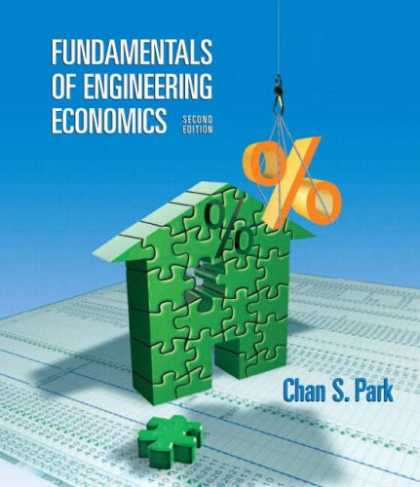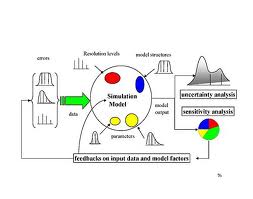Topic outline
-
-
Forum
-
File
-
Folder
-
Chapter 1 :Foundations of Engineering Economy

Introduction:
This chapter provides you with an understanding of the basic concepts and terminology necessary to perform an engineering economy analysis. it explains the role of engineering economy in the decision _making process and describes the major elements of an engineering economy study.Finally, a basic graphical approach_the cash-flow diagram_is introduced.
Objectives:
This chapter will help you :
-
Understand the types of questions engineering economy can help you answer.
-
Determine the role of engineering economy in the decision _making process.
-
Identify the major components of an engineering economy study and what is needed to successfully perform one.
-
Perform calculations about interest and interest rates.
-
Determine what equivalence means.
-
Calculate simple interest and compound interest for one or more interest periods.
-
Identify the common engineering economy symbols.
-
Know the meaning of minimum attractive Rate of Return(MARR).
-
Understand cash flow and how to graphically depict it.
-
Use the rule of 72 to estimate an interest rate or number of years for an amount to double.
Plan:
First: Read the following file.
-
-
Chapter 2 :Factors and their use

Introduction:
In this chapter we learn the derivation of the engineering economy factors and the use of these basic factors in concepts presented here are relied upon through_out the text.
Objectives:
This chapter will help you :
-
Derive the single-payment compound-amount and present -worth factors.
-
Derive the uniform-series present-worth and capital-recovery factors.
-
Derive the uniform -series compound-amount and sinking-fund factors.
-
Find the correct factor value in a table.
-
Derive the uniform -gradient present-worth and annual series factors.
-
Derive the geometric (escalating) gradient formula.
-
Linearly interpolate to find a factor value.
-
Calculate the present worth ,future worth ,or annual worth of various cash flows.
-
Calculate the present worth, future worth, or annual worth of cash flows involving a uniform gradient.
-
Calculate the present worth, future worth, or annual worth of cash flows involving a geometric gradient.
-
Calculate the interest rate (rate of return) of a sequence of cash flows.
-
Determine the number of years n required for equivalence for a sequence of cash flows.
Plan:
First: Read the following file
-
-
Chapter 3 :Nominal & Effective Interest Rates.

Introduction:
In all engineering economy relations developed thus far, the interest rate has been a constant, annual value. For a substantial percentage of the projects evaluated by professional engineers in practice, the interest rate is compounded more frequently than once a year; frequencies such as semiannual, quarterly, and monthly are common. In fact, weekly, daily, and even continuous compounding may be experienced in some project evaluations. Also, in our own personal lives, many of the financial considerations we make—loans of all types (home mortgages, credit cards, automobiles, boats), checking and savings accounts, investments, stock option plans, etc.—have interest rates compounded for a time period shorter than 1 year. This requires the introduction of two new terms—nominal and effective interest rates.
This chapter explains how to understand and use nominal and effective interest rates in engineering practice and in daily life situations. The flowchart on calculating an effective interest rate in the appendix to this chapter serves as a reference throughout the sections on nominal and effective rates, as well as continuous compounding of interest. This chapter also develops equivalence calculations for any compounding frequency in combination with any cash flow frequency.
Objectives:
This chapter will help you :
-
Define compounding period,nominal interest rate,effective interest rate,and payment period.
-
Understand the formula for calculating effective interest rates.
-
Calculate the effective interest rate and find any factor for that rate.
-
Derive and use the formula for continuous compounding.
-
Make equivalence calculations for payment periods equal to or longer than the compounding period.
-
Make equivalence calculations for payment periods shorter than the compounding period.
Plan:
First: Read the following file bellow.
-
Assignment
-
-
Chapter 4 :Use of multiple factors

Introduction:
Because many of the cash-flow situations encountered in real-world engineering problems do not fit exactly the cash-flow sequences for which the equations in chapter2 were developed,it is common to combine the equations.for a given sequence of cash flows, there are usually many ways to determine the equivalent present worth, future -worth,or annual -worth cash flows.In this chapter ,you will learn how to combine several of the engineering economy factors in order to address these more complex situations.
Objectives:
This chapter will help you :
-
Determine the location of present worth or future worth for randomly placed uniform series.
-
Determine PW, FW , or AW of a series starting at a time other than year .
-
Calculate PW or FW of randomly placed single amounts and uniform series amounts.
-
Calculate AW of randomly placed single amounts and uniform series amounts.
-
Make equivalence calculations for cash flows involving shifted uniform or geometric gradients.
-
Make equivalence calculations for cash flows involving decreasing gradients.
Plan:
First: Read the following file.
-
-
Chapter 5 :present worth and capitalized-cost evaluation.

Introduction:
A future amount of money converted to its equivalent value now has a present worth (PW) that is always less than that of the actual cash flow, because for any interest rate greater than zero, all P/F factors have a value less than 1.0. For this reason, present worth values are often referred to as discounted cash flows (DCF). Similarly, the interest rate is referred to as the discount rate. Besides PW, two other terms frequently used are present value (PV) and net present value (NPV). Up to this point, present worth computations have been made for one project or alternative. In this chapter, techniques for comparing two or more mutually exclusive alternatives by the present worth method are treatedSeveral extensions to PW analysis are covered here—future worth, capitalized cost, payback period, life-cycle costing, and bond analysis—these all use present worth relations to analyze alternatives. In order to understand how to organize an economic analysis, this chapter begins with a description of independent and mutually exclusive projects, as well as revenue and service alternatives. The case study examines the payback period and sensitivity for a public sector project.
Objectives:
This chapter will help you :
-
Select the best of equal-life alternatives using present worth calculations.
-
Select the best of different life alternatives using present worth calculations.
-
Describe a life cycle cost analysis for the major cost categories of an alternative.
-
Make capitalized cost calculations.
-
Select the best alternative using capitalized cost calculations
Plan:
First: Read the following file
-
File
-
File
-
Quiz
-
-
Chapter 6 :Annual worth analysis

Introduction:
The objectives of this chapter are to explain and demonstrate the primary methods of calculating the equivalent uniform annual worth of an asset and how to select the better of two alternatives on the basis of an annual-worth comparison.Although the word annual is included in the name of the method ,the procedures developed in this chapter can be used to find an equivalent uniform series over any interest period desired,as per chapter 3 .Additionally ,the word cost is often used interchangeably with worth in describing a series so that annual cost and AW mean the same thing.However,AW more properly describes the cash flow because oftentimes the uniform series developed represents an income rather than a cost .
Objectives:
This chapter will help you :
-
Understand why AW needs to be calculated over only one life cycle.
-
Calculate AW using the sinking -fund method.
-
Calculate AW using the salvage present worth method.
-
Calculate AW using capital recovery-plus-interest method
-
Select the best alternative.
- Calculate the AW of a Perpetual investment involving a perpetual uniform series
Plan:
First: Read the following file
-
-
Chapter 7 :Rate of return for one project

Introduction:
In this chapter,the procedure to correctly compute the rate of return for one project based on a present-worth or annual-worth equation is discussed.since ROR calculations frequently require a manual trial-and-error method,or a spreadsheetsystemforquickerresolution,procedures for estimating the interest rate that will satisfy the ROR equation are presented. One of the dilemmas of ROR analysis is that, in some cases,multiple values of i will satisfy the ROR equation.We explain how to recognize this possibility and the correct approach to obtain the ROR value by using a reinvestment rate for the project's positive net cash flows.Only one project is considered in this chapter,however,the next chapter applies the principles discussed here for selection from two and more alternatives
Objectives:
This chapter will help you :
-
Understand the basis of rate of return calculations.
-
Calculate the rate of return using a present worth equation.
-
Calculate the rate of return using an annual worth equation.
-
Determine the maximum number of possible ROR values for a non conventional (non simple) cash flow sequence.
-
Calculate the composite rate of return using a stated reinvestment rate.
Plan:
First:Read the following file.
-
-
Chapter 8 :ROR Analysis for Multiple Alternatives.

Introduction:
This chapter presents the methods by which two or more alternatives can be evaluated using a rate of return comparison. The ROR evaluation correctly performed will result in the same selection as the PW and AW analysis, but the computational procedure is considerably different for ROR evaluations
Objectives:
This chapter will help you :
-
State why an incremental investment analysis is necessary for comparing alternatives by the ROR method
-
Prepare a tabulation of incremental cash flow for two alternatives.Calculate the rate of return using an annual worth equation.
-
Interpret the meaning of ROR on the incremental investment.
-
Select the better of two alternatives using an ROR relation based on present worth
-
Select the better of two alternatives using an ROR relation based on annual worth.
- Select the best of multiple alternatives using the ROR method.
Plan:
First: Read the following file
-
-
Chapter 9 :Benefit & Cost Analysis

Introduction:
This chapter explain the evaluation and comparison of alternatives on the basis of the benefit/cost ratio. Though this method is sometimes regarded as supplementary, since it is commonly used in conjunction with a present-worth or annual worth analysis,it is an analytical technique we must all understand.Besides its use in business and industry, the B/C method is utilized on many government and public works projects to determine if it is expected benefits provide an acceptable return on the estimated investment and costs.
Objectives:
This chapter will help you :
-
Classify cash flow as benefits,costs,or dis benefits.
-
Calculate the benefit/cost ratio of a single project
-
Select the better of two alternatives using the B/C ratio method
-
Select the best from multiple alternatives using the B/C method
Plan:
First: Read the following file.
-
-
Chapter 10 :Tariff

Introduction:
The electrical energy produced by a power station is delivered to a large number of consumers. The tariff is the rate at which electrical energy is sold naturally becomes attention inviting for electric supply company. Tariff – The rate at which electrical energy is supplied to a consumer is known as tariff. Although tariff should include the total cost of producing and supplying electrical energy plus the profit, yet it cannot be the same for all types of consumers.
Objectives:
This chapter will help you :
-
Destinguish between different type of tariff
- Single tariff.
- Flat rate tariff.
- Block rate tariff.
- Two part tariff.
- Maximum demad tariff.
- Power factor tariff.
- Three part tariff.
-
Solve examples about different type of tariff.
Plan:
First: Read the following file
-
File
-
File
-
-
Chapter 12 :Sensitivity Analysis and expected value decision.

Introduction:
Sensitivity analysis, itself a study usually performed in conjunction with the engineering economy study, determines how a measure of worth – Pw, Aw, ROR or B/C and the alternative selected will be altered if a particular factor or parameter varies over a stated range of values.
Plotting the sensitivity of PW, AW or ROR versus the parameter studied is very helpful. Two alternatives can be compared with respect to a given parameter and the breakeven point computed. This is the value at which the two alternatives are economically equivalent.
Objectives:
This chapter will help you in:
1- Knowing the Approach to Sensitivity Analysis.
2- Determining Sensitivity to Parameter Estimates.
3- Finding Sensitivity Analysis Using Three Estimates.
4- Economic Variability and the Expected Value.
5- Expected – Value Computations for Alternatives.
6-Making Alternative Selection Using Decision Trees.
plan:
First: Read the following file.




